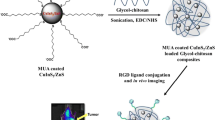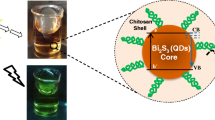Abstract
Quantum dots (QD) or semiconductor nanoparticles are within the most researched nanomaterials currently. Their attractive optical, electronic and chemical properties can be adjusted by varying composition, size, and synthesis parameters. This tunability pushes these nanocrystals into different types of applications such as biomedical and environmental ones. One of the concerns about their use regards the inherent toxicity related to the most efficient emission QD based on heavy metals. In this context, we report the synthesis of eco-friendly Ag-In-S (AIS) and Zn-Ag-In-S (ZAIS) QD conjugated with a biodegradable polymer, carboxymethylcellulose (CMC). Colloidal AIS were synthesized using an eco-friendly aqueous route at room temperature. Co-precipitation process was controlled via CMC with two degrees of substitution (DS) and under different pH conditions. In order to improve the as-prepared AIS’ optical properties, ZnS was deposited over the nanocrystals with further annealing process, creating a core/shell alloyed nanostructure. The obtained QD were extensively characterized considering their optical, physicochemical and morphological features. Results demonstrated the presence of fairly monodispersed photoluminescent nanoparticles with average size of 3.0 nm for AIS QD and 4.3 nm for ZAIS QD. Moreover, modifying the synthesis parameters, it was possible to tune and improve the emission of the fluorescent nanoparticles (λem = 500 to 900 nm). Diffraction patterns suggested the formation of solid solutions of AIS and its correspondent binary compounds. Furthermore, cellular uptake assays demonstrated a more rapid internalization of fluorescent AIS and ZAIS nanoconjugates by cancer cells when compared to normal cells. These luminescent materials showed the potential of use in a wide range of applications, such as bioimaging of cancer cells.
















Similar content being viewed by others
References
Yin Y, Alivisatos AP (2005) Colloidal nanocrystal synthesis and the organic–inorganic interface. Nature 437:664
Whitesides GM (2005) Small 1:172
Shen S, Wang Q (2013) Chem Mater 25:1166
Fang M, Peng CW, Pang DW, Li Y (2012) Quantum dots for cancer research: current status, remaining issues, and future perspectives. Cancer Biol Med 9:151–163
Ferrari M (2005) Cancer nanotechnology: opportunities and challenges. Nat Rev Cancer 5:161–171
Szopa W, Burley TA, Kramer-Marek G, Kaspera W (2017) BioMed Res Int 2017:13
Wang Y, Chen L (2011) Nanomedicine 7:385
Oh E, Liu R, Nel A, Gemill KB, Bilal M, Cohen Y, Medintz IL (2016) Nature Nanotech 11:479
Rocha TL, Mestre NC, Sabóia-Morais SMT, Bebianno MJ (2017) Environ Int 98:1
Xu G, Zeng S, Zhang B, Swihart MT, Yong K-T, Prasad PN (2016) Chem Rev 116:12234
Javidi J, Haeri A, Kobarfard F, Dadashzadeh S (2017) J Clust Sci 28:165
Drbohlavova J, Adam V, Kizek R, Hubalek J (2009) Int J Mol Sci 10:656
Chen B, Pradhan N, Zhong H (2018) J Phys Chem Lett 9:435
Kobosko SM, Kamat PV (2018) J Phys Chem C 122:14336
Bera D, Qian L, Tseng T-K, Holloway P (2010) Materials 3:2260
Vasudevan D, Gaddam RR, Trinchi A, Cole I (2015) J Alloy Compd 636:395
Medeiros Borsagli FGL, Borsagli A (2019) J Polym Environ 27:1542–1556
Zheng WJ, Gao J, Wei Z, Zhou J, Chen JM (2015) Eur Polym J 72:514
Reza AT, Nicoll SB (2010) Acta Biomater 6:179
Chang JY, Wang G-Q, Cheng C-Y, Lin W-X, Hsu J-C (2012) J Mater Chem 22:10609
Raevskaya A, Lesnyak V, Haubold D, Dzhagan V, Stroyuk O, Gaponik N, Zahn DRT, Eychmüller A (2017) J Phys Chem C 121:9032
Jagadeeswararao M, Swarnkar A, Markad GB, Nag A (2016) J Phys Chem C 120:19461
Grubbs RB (2007) Polym Rev 47:197
Donegá CM (2010) Chem Soc Rev 40:1512
Tauc J, Menth A, Non-Cryst J (1972) Solids 8:569
Uskoković V (2008) Colloids Surf B 61:250
Sunardi NM, Febriani AB (2017) Junaidi. AIP Conf Proc 1868:20008
Ivashchenko IA, Danyliuk IV, Olekseyuk ID, Pankevych VZ, Halyan VV (2015) J Solid State Chem 227:255
Sachanyuk VP, Gorgut GP, Atuchin VV, Olekseyuk ID, Parasyuk OV (2008) J Alloy Compd 452:348
Takeno N (2005) Atlas of Eh-pH diagrams, geological survey of japan open file report
Hamanaka Y, Ogawa T, Tsuzuki M, Kuzuya T (2011) J Phys Chem C 115:1786
Green M (2010) J Mater Chem 20:5797
Grandhi GK, Arunkumar M, Viswanatha R (2016) J Phys Chem C 120:19785
Zhou H, Alves H, Hofmann DM, Kriegseis W, Meyer BK, Kaczmarczyk G, Hoffmann A (2002) Appl Phys Lett 80:210
Wilhelm S, Tavares AJ, Dai Q, Ohta S, Audet J, Dvorak HF, Chan WCW (2016) Analysis of nanoparticle delivery to tumours. Nat Rev Mater 1:1–12
Atlas of Eh–pH diagrams, intercomparison of thermodynamic databases, geological survey of japan open file report No. 419 2005
Raucci MG, Alvarez-Perez MA, Demitri C, Giugliano D, De Benedictis V, Sannino A, Ambrosio L (2015) Effect of citric acid crosslinking cellulose-based hydrogels on osteogenic differentiation. J Biomed Mater Res Part A 103A:2045–2056
Zeleňák V, Vargová Z, Györyová K (2007) Spectrochim Acta A 66:262
Sutton CCR, da Silva G, Franks GV (2015) Chem Eur J 21:6801
Regulacio M, Win K, Lo S, Zhang S-Y, Zhang X, Wang S, Han M-Y, Zheng Y (2013) Nanoscale 5:2322
Hamanaka Y, Ogawa T, Tsuzuki M, Ozawa K, Kuzuya T (2013) J Lumin 133:121
Mir IA, Radhakrishanan VS, Rawat K, Prasad T, Bohidar HB (2018) Sci Rep 8:9322
Kang X, Huang L, Yang Y, Pan D (2015) J Phys Chem C 119:7933
Resch-Genger U, Grabolle M, Cavaliere-Jaricot S, Nitschke R, Nann T (2008) Nat Methods 5:763
Allen M, Bjerke M, Edlund H, Nelander S, Westermark B (2016) Sci Transl Med 8:354re3
Vaidyanathan S, Orr BG, Banaszak Holl MM (2014) J Phys Chem B 118:2112
Al-Hajaj NA, Moquin A, Neibert KD, Soliman GM, Winnik FM, Maysinger D (2011) ACS Nano 5:4909
Clift MJD, Brandenberger C, Rothen-Rutishauser B, Brown DM, Stone V (2011) Toxicology 286:58
Song J, Ma C, Zhang W, Yang S, Wang S, Lv L, Zhu L, Xia R, Xu X (2016) J Mater Chem B 4:7909
Acknowledgements
The authors thank for the assistance of Department of Chemical and Odontology of Universidade Federal dos Vales do Jequitinhonha e Mucuri (UFVJM).
Funding
The authors acknowledge the financial support from the following Brazilian research agencies CAPES, CNPq, FAPEMIG and FINEP. The Funding was and so funded by Conselho Nacional de Desenvolvimento Científico e Tecnológico.
Author information
Authors and Affiliations
Corresponding authors
Ethics declarations
Conflict of interest
The authors declare that they have no competing interests.
Additional information
Publisher's Note
Springer Nature remains neutral with regard to jurisdictional claims in published maps and institutional affiliations.
Rights and permissions
About this article
Cite this article
Paiva, A.E., Medeiros Borsagli, F.G.L. Ecofriendly Multiphase Aqueous Colloidal Based on Carboxymethylcellulose Nanoconjugates with Luminescence Properties for Potential Bioimaging Cancer Cells. J Polym Environ 28, 3076–3096 (2020). https://doi.org/10.1007/s10924-020-01825-5
Published:
Issue Date:
DOI: https://doi.org/10.1007/s10924-020-01825-5




